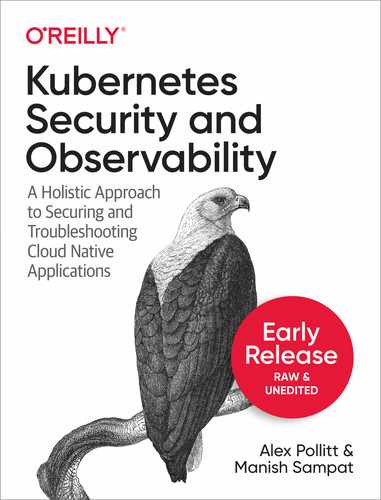This practical book introduces new cloud native approaches for Kubernetes practitioners, like yourself, who care about the security and observability of mission-critical microservices. Through practical guidance and best practice recommendations, this book helps you understand why cloud native applications require a modern approach to security and observability practices and how to implement them. Do you want to know how to secure and troubleshoot your cloud native applications? Or are you part of a group that wants to solve security and observability challenges before fully adopting Kubernetes in your organization? This book takes you through the full breadth of new cloud native approaches for establishing security and observability with Kubernetes.
Table of Contents
- Preface
- 1. Security Strategy
- 2. Infrastructure Security
- Host hardening
- Choice of operating system
- Non-essential processes
- Host based firewalling
- Always research the latest best practices
- Cluster hardening
- Secure the Kubernetes datastore
- Secure the Kubernetes API server
- Encrypt Kubernetes secrets at rest
- Rotate credentials frequently
- Authentication & RBAC
- Restricting cloud metadata API access
- Enable auditing
- Restrict access to alpha or beta features
- Upgrade Kubernetes frequently
- Use a managed Kubernetes service
- CIS Benchmarks
- Network security
- Conclusion
- 3. Workload Deployment Controls
- Image building and scanning
- Choice of a base image
- Container image hardening
- Container image scanning solution
- Privacy concerns
- Container threat analysis
- CI/CD
- Scan images by registry scanning services
- Scan images after builds
- Inline image scanning
- Kubernetes admission controller
- Securing CI/CD pipeline
- Organization policy
- Secrets management
- etcd to store secrets
- Secret management service
- Kubernetes secrets store CSI driver
- Secrets management best practises
- Authentication
- Authorization
- Conclusion
- 4. Workload Runtime Security
- 5. Network Policy
- What is network policy?
- Why is network policy important?
- Network policy implementations
- Network policy best practices
- Ingress and egress
- Not just mission critical workloads
- Policy and label schemas
- Default deny and default app policy
- Policy tooling
- Development processes & microservices benefits
- Policy recommendations
- Policy impact previews
- Policy staging / audit modes
- Conclusion
- 6. Managing Trust Across Teams
- 7. Exposing Services to External Clients
- Understanding direct pod connections
- Understanding Kubernetes Services
- Cluster IP services
- Node port services
- Load Balancer Services
- externalTrafficPolicy:local
- Network policy extensions
- Alternatives to kube-proxy
- Direct Server Return
- Limiting service external IPs
- Advertising service IPs
- Understanding Kubernetes Ingress
- In-cluster ingress solutions
- External ingress solutions
- Conclusion
- 8. Encryption of Data in Transit
